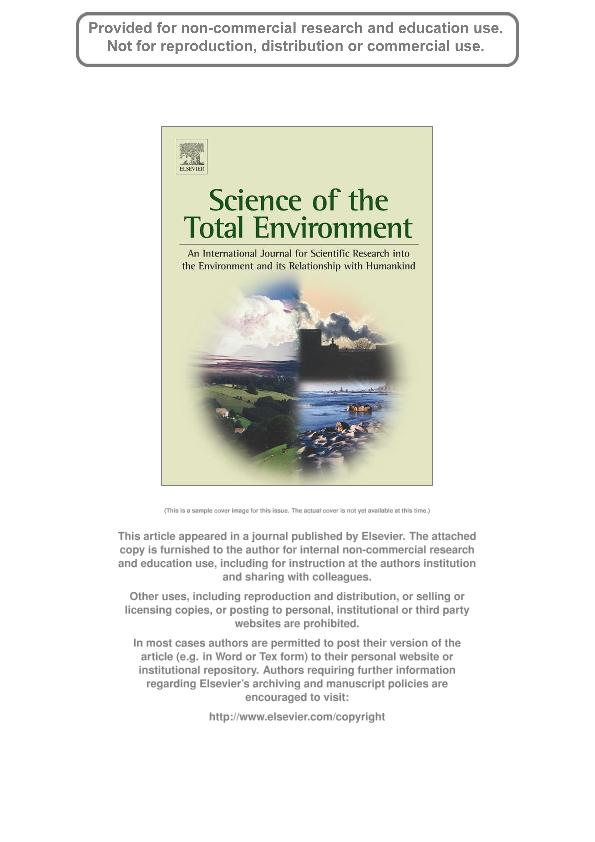Mostrar el registro sencillo del ítem
dc.contributor.author
Diaz Jaramillo, Mauricio Javier

dc.contributor.author
Muñoz , Claudia
dc.contributor.author
Rudolph, Ignacio
dc.contributor.author
Servos, Mark
dc.contributor.author
Barra, Ricardo
dc.date.available
2017-09-26T15:24:12Z
dc.date.issued
2013-01-01
dc.identifier.citation
Diaz Jaramillo, Mauricio Javier; Muñoz , Claudia; Rudolph, Ignacio; Servos, Mark; Barra, Ricardo; Seasonal mercury concentrations and δ15N and δ13C values of benthic macroinvertebrates and sediments from a historically polluted estuary in south central Chile; Elsevier Science; Science of the Total Environment; 442; 1-1-2013; 198-206
dc.identifier.issn
0048-9697
dc.identifier.uri
http://hdl.handle.net/11336/25107
dc.description.abstract
The Lenga Estuary is one of the most industrialized sites in south central Chile where the historic operation of chlor-alkali plants resulted in large quantities of mercury (Hg) being deposited into the estuary. This historical contamination may still represent a risk to the biota in the estuary. To investigate this four macroinvertebrates, Neotrypaea uncinata (ghostshrimp), Elminius kingii (barnacle), Hemigrapsus crenulatus (shore crab) and Perinereis gualpensis (ragworm) were collected seasonally from three different sites in the Lenga Estuary and one in a reference estuary (Tubul Estuary), and analyzed for Hg and stable isotopes (δ15N and δ13C). Mercury concentrations in Lenga sediments ranged from 0.4 ± 0.1 to 13 ± 3 mg/kg, while those in Tubul sediments ranged from 0.02 ± 0.01 to 0.07 ± 0.09 mg/kg. Total Hg concentrations of invertebrates were significantly different between estuaries (p < 0.05), but not by species or season for each estuary (p > 0.05). In contrast, organic Hg concentrations were different by species and season with shore crab muscle tissues exhibiting the greatest percent difference. Site-specific relationships demonstrated that total Hg concentrations in ragworm best reflected the total Hg sediment mercury concentrations. Signatures of δ13C were correlated to the organic Hg % rather than total Hg. This suggests that organic Hg concentrations in these species were related to the carbon sources.
dc.format
application/pdf
dc.language.iso
eng
dc.publisher
Elsevier Science

dc.rights
info:eu-repo/semantics/openAccess
dc.rights.uri
https://creativecommons.org/licenses/by-nc-sa/2.5/ar/
dc.subject
Mercury
dc.subject
Organic Mercury
dc.subject
Stable Isotopes
dc.subject
Estuary
dc.subject
Invertebrates
dc.subject.classification
Oceanografía, Hidrología, Recursos Hídricos

dc.subject.classification
Ciencias de la Tierra y relacionadas con el Medio Ambiente

dc.subject.classification
CIENCIAS NATURALES Y EXACTAS

dc.title
Seasonal mercury concentrations and δ15N and δ13C values of benthic macroinvertebrates and sediments from a historically polluted estuary in south central Chile
dc.type
info:eu-repo/semantics/article
dc.type
info:ar-repo/semantics/artículo
dc.type
info:eu-repo/semantics/publishedVersion
dc.date.updated
2017-09-21T18:01:52Z
dc.journal.volume
442
dc.journal.pagination
198-206
dc.journal.pais
Países Bajos

dc.journal.ciudad
Amsterdam
dc.description.fil
Fil: Diaz Jaramillo, Mauricio Javier. Universidad de Concepción; Chile. Consejo Nacional de Investigaciones Científicas y Técnicas; Argentina
dc.description.fil
Fil: Muñoz , Claudia. Universidad de Concepción; Chile
dc.description.fil
Fil: Rudolph, Ignacio. Universidad de Concepción; Chile
dc.description.fil
Fil: Servos, Mark. University Of Waterloo; Canadá
dc.description.fil
Fil: Barra, Ricardo. Universidad de Concepción; Chile
dc.journal.title
Science of the Total Environment

dc.relation.alternativeid
info:eu-repo/semantics/altIdentifier/url/http://www.sciencedirect.com/science/article/pii/S0048969712013216
dc.relation.alternativeid
info:eu-repo/semantics/altIdentifier/doi/http://dx.doi.org/10.1016/j.scitotenv.2012.10.039
Archivos asociados
